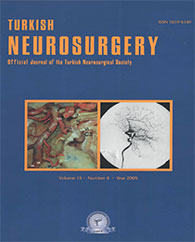2Department of Neurosurgery, School of Medicine, Hacettepe University, Ankara, Turkey OBJECTIVE: The variations and anomalies of intracranial arteries may affect the treatment strategy and patients' outcome during neurosurgical and interventional neuroradiological procedures.
METHODS: The construction of intracranial arteries was evaluated on cerebral angiograms in patients admitted to the interventional neuroradiology unit. The carotid and vertebrobasilar systems were also studied on 30 cadaveric head specimens (bilaterally) during dissections by different skull base approaches. This data was reviewed taking the surgical correlation into consideration with the relevant literature.
RESULTS: A persistent trigeminal artery (PTA) and an extradural posterior inferior cerebellar artery (e-PICA) were observed during cadaveric dissections. The following variations were observed on cerebral angiograms in patients with aneurysms, arteriovenous malformations or other vascular pathologies, and on angiograms without any pathological condition: persistent trigeminal artery (PTA), extradural posterior inferior cerebellar artery (e-pica), median callosal artery (accessory), agenesis of the A1 segment, fenestrated and accessory middle cerebral artery, early bifurcation of middle cerebral artery and ophthalmic artery originating from the cavernous carotid artery.
CONCLUSION: In neurosurgical and interventional neuroradiological practice, pre- and perprocedure studies should be performed meticulously to observe different variations of cerebral arteries.
Keywords : Extradural posterior inferior cerebellar artery, Median callosal artery, Pericallosal azygos artery, Persistent trigeminal artery, Variations of middle cerebral artery




